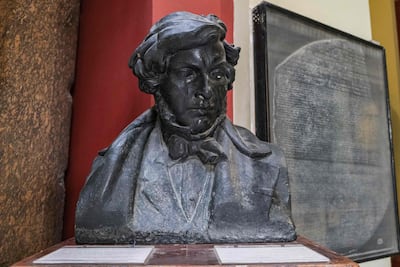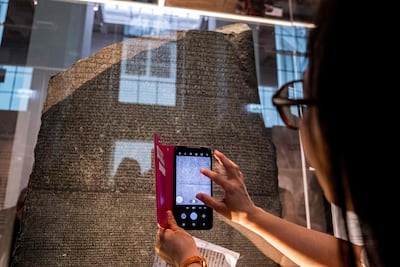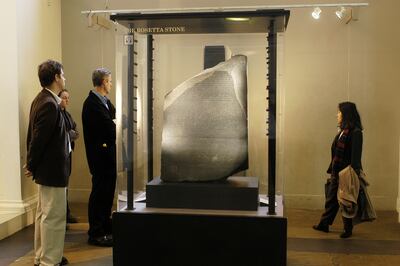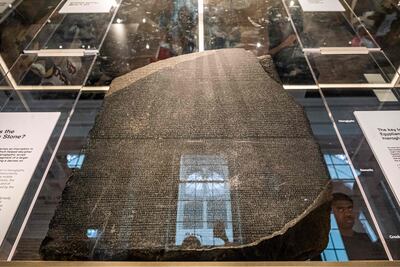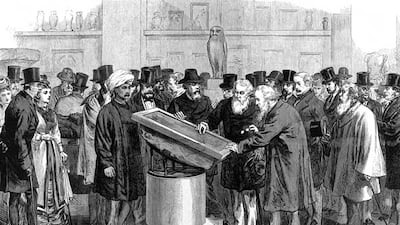For centuries they were an impenetrable mystery. Hieroglyphs, pictorial writing found on ancient monuments, represented the lost language of the Egyptian pharaohs.
The code was finally cracked 200 years ago with the presentation on September 27, 1822, to a Paris academy by Jean-Francois Champollion, a gifted linguist with a passion for ancient Egypt.
Five days earlier, Champollion had made the final breakthrough, a moment so exciting that after shouting “I’ve got it,” he fainted and had to spend the next few days in bed to recover.
At the heart of the mystery was the Rosetta Stone, a 720 kilgram slab of granodiorite, a rock similar to granite, and now housed in the British Museum in London.
The story of the Rosetta Stone is almost as complex as the decoding of the hieroglyphs inscribed on its surface.
It was discovered in July 1799 during renovations to a fort at Rosetta, now called Rasheed, on the Nile Delta. Napoleon had invaded Egypt the previous year, bringing not just an army of troops but also scholars of Egyptian history, with which Napoleon had become obsessed.
The significance of the Rosetta Stone was almost instantly recognised. It carried three panels of text, one in hieroglyphs and another in a then-unknown language.
The third was ancient Greek, a language well known and understood by 19th-century classical scholars. That revealed the stone — or stele — was a proclamation to establish the authority of the then child-pharaoh Ptolemy V, and was carved around 186BC.
It also became clear that the other two panels carried exactly the same text. Suddenly the door opened to understanding hieroglyphs by comparing them with Greek.
Copies of the text began to circulate widely among scholars in Europe and even the US, but the actual stone was on a different path. Napoleon’s fleet had been destroyed by Admiral Horatio Nelson at the Battle of the Nile in 1798, and his demoralised army finally surrendered to the British in 1801.
Despite French protests, the Rosetta Stone was taken as a spoil of war and presented to King George III, who gave it to the British Museum where it has been displayed ever since.
The hieroglyphs, though, remained a mystery. Much of the text was damaged or missing, and so little was known, it was not clear if they should be read left to right, or the reverse or even up and down.
One popular theory was that they were not even a written language but instead expressed spiritual ideas.
The first breakthrough came from an English doctor, Thomas Young, who began studying the stone in 1814. Young, known as the “Phenomenon” for his scientific discoveries, eventually deduced that the hieroglyphs were phonetic when they involved names, including Ptolemy.
Young’s work was then taken up by Champollion in 1820. Working on the theory of phonetics, he eventually realised that all hieroglyphs were phonetic and that they could also be pictorial. Several hieroglyphs could also represent one word, breaking it into consonants.
It was an extraordinary achievement. Hieroglyphs had developed as a written form of ancient Egyptian from around 3,300 BCE and had become extinct by the 4th century AD.
They were designed to be read only by the most educated, including priests, at a time when most people were virtually illiterate. This was where the second panel on the Rosetta Stone came in. It was in Demotic, a script based on alphabet symbols rather than hieroglyphs and far easier to read and write. Over time it replaced hieroglyphs in everything but religious texts and evolved eventually into Coptic, the language of Egypt's indigenous Christians.
The first Demotic words on the stone were also translated by a French man, Silvestre de Sacy. An expert in Arab languages, he taught and encouraged Champollion in his early work, but eventually fell out with him, calling his rival a fraud.
Likewise, Champollion and Young were initially complimentary about each other's work, but relations cooled over who should take credit for the discovery — the English or the French?
Neither lived long enough to appreciate their fame. Champollion died in 1832 aged 41 and Young in 1829 at 55. Only de Sacy, his contribution largely forgotten, enjoyed old age, dying at 79 in 1838.
The Rosetta Stone can be found today in Room 4 of the British Museum, part of its collection of Egyptian sculptures, of which it is the greatest treasure.
Now displayed behind protective glass, it has been there for 220 years, except for a period in the First World War when it was moved to a tunnel 50 feet underground as protection against air raids.
Egypt, though, excluded from decisions about the stone’s future since the end of the 18th century, would like to have it back.
As reported in The National last month, the renowned Egyptian archaeologist Dr Zahi Hawass has launched a petition for the return of three of his country's most prized artefacts including the Rosetta Stone, a Zodiac ceiling in the Louvre in Paris, and a bust of Queen Nefertiti held by Berlin’s Neuse Museum.
“The Rosetta Stone is the icon of Egyptian identity”, he said in an exclusive interview. “The British Museum has no right to show this artefact to the public.”
For its part, the British Museum says no official request has been made for the stone’s return. The subtext, as with the Elgin Marbles demanded by Greece, is that millions more people from around the world have been able to see the stone in London than if it was in its original home.
Later this year the new Grand Egyptian Museum is due to open in the shadow of the pyramids in Cairo. Although there is no place yet for the Rosetta Stone, among other artefacts are the contents of Tutankhamun’s tomb.
The archaeologists who found the tomb In November 1922 first knew it was Tutankhamun because they could read his name on the door seals — all thanks to the work of Champollion a century earlier.
UAE currency: the story behind the money in your pockets
What is hepatitis?
Hepatitis is an inflammation of the liver, which can lead to fibrosis (scarring), cirrhosis or liver cancer.
There are 5 main hepatitis viruses, referred to as types A, B, C, D and E.
Hepatitis C is mostly transmitted through exposure to infective blood. This can occur through blood transfusions, contaminated injections during medical procedures, and through injecting drugs. Sexual transmission is also possible, but is much less common.
People infected with hepatitis C experience few or no symptoms, meaning they can live with the virus for years without being diagnosed. This delay in treatment can increase the risk of significant liver damage.
There are an estimated 170 million carriers of Hepatitis C around the world.
The virus causes approximately 399,000 fatalities each year worldwide, according to WHO.
Company Fact Box
Company name/date started: Abwaab Technologies / September 2019
Founders: Hamdi Tabbaa, co-founder and CEO. Hussein Alsarabi, co-founder and CTO
Based: Amman, Jordan
Sector: Education Technology
Size (employees/revenue): Total team size: 65. Full-time employees: 25. Revenue undisclosed
Stage: early-stage startup
Investors: Adam Tech Ventures, Endure Capital, Equitrust, the World Bank-backed Innovative Startups SMEs Fund, a London investment fund, a number of former and current executives from Uber and Netflix, among others.
How to wear a kandura
Dos
- Wear the right fabric for the right season and occasion
- Always ask for the dress code if you don’t know
- Wear a white kandura, white ghutra / shemagh (headwear) and black shoes for work
- Wear 100 per cent cotton under the kandura as most fabrics are polyester
Don’ts
- Wear hamdania for work, always wear a ghutra and agal
- Buy a kandura only based on how it feels; ask questions about the fabric and understand what you are buying
World Cricket League Division 2
In Windhoek, Namibia - Top two teams qualify for the World Cup Qualifier in Zimbabwe, which starts on March 4.
UAE fixtures
Thursday February 8, v Kenya; Friday February 9, v Canada; Sunday February 11, v Nepal; Monday February 12, v Oman; Wednesday February 14, v Namibia; Thursday February 15, final
PROFILE OF SWVL
Started: April 2017
Founders: Mostafa Kandil, Ahmed Sabbah and Mahmoud Nouh
Based: Cairo, Egypt
Sector: transport
Size: 450 employees
Investment: approximately $80 million
Investors include: Dubai’s Beco Capital, US’s Endeavor Catalyst, China’s MSA, Egypt’s Sawari Ventures, Sweden’s Vostok New Ventures, Property Finder CEO Michael Lahyani
More from Neighbourhood Watch
Overview
What: The Arab Women’s Sports Tournament is a biennial multisport event exclusively for Arab women athletes.
When: From Sunday, February 2, to Wednesday, February 12.
Where: At 13 different centres across Sharjah.
Disciplines: Athletics, archery, basketball, fencing, Karate, table tennis, shooting (rifle and pistol), show jumping and volleyball.
Participating countries: Algeria, Bahrain, Comoros, Egypt, Iraq, Jordan, Kuwait, Lebanon, Libya, Morocco, Oman, Palestine, Saudi Arabia, Sudan, Syria, Tunisia, Qatar and UAE.
Jurassic%20Park
%3Cp%3E%3Cstrong%3EDirector%3A%20%3C%2Fstrong%3ESteven%20Spielberg%3Cbr%3E%3Cstrong%3EStars%3A%3C%2Fstrong%3E%20Sam%20Neill%2C%20Jeff%20Goldblum%20and%20Richard%20Attenborough%3Cbr%3E%3Cstrong%3ERating%3A%3C%2Fstrong%3E%205%2F5%3C%2Fp%3E%0A
'Outclassed in Kuwait'
Taleb Alrefai,
HBKU Press
Joe Root's Test record
Tests: 53; Innings: 98; Not outs: 11; Runs: 4,594; Best score: 254; Average: 52.80; 100s: 11; 50s: 27
Thor: Ragnarok
Dir: Taika Waititi
Starring: Chris Hemsworth, Tom Hiddleston, Cate Blanchett, Jeff Goldblum, Mark Ruffalo, Tessa Thompson
Four stars
Diriyah%20project%20at%20a%20glance
%3Cp%3E-%20Diriyah%E2%80%99s%201.9km%20King%20Salman%20Boulevard%2C%20a%20Parisian%20Champs-Elysees-inspired%20avenue%2C%20is%20scheduled%20for%20completion%20in%202028%0D%3Cbr%3E-%20The%20Royal%20Diriyah%20Opera%20House%20is%20expected%20to%20be%20completed%20in%20four%20years%0D%3Cbr%3E-%20Diriyah%E2%80%99s%20first%20of%2042%20hotels%2C%20the%20Bab%20Samhan%20hotel%2C%20will%20open%20in%20the%20first%20quarter%20of%202024%0D%3Cbr%3E-%20On%20completion%20in%202030%2C%20the%20Diriyah%20project%20is%20forecast%20to%20accommodate%20more%20than%20100%2C000%20people%0D%3Cbr%3E-%20The%20%2463.2%20billion%20Diriyah%20project%20will%20contribute%20%247.2%20billion%20to%20the%20kingdom%E2%80%99s%20GDP%0D%3Cbr%3E-%20It%20will%20create%20more%20than%20178%2C000%20jobs%20and%20aims%20to%20attract%20more%20than%2050%20million%20visits%20a%20year%0D%3Cbr%3E-%20About%202%2C000%20people%20work%20for%20the%20Diriyah%20Company%2C%20with%20more%20than%2086%20per%20cent%20being%20Saudi%20citizens%0D%3C%2Fp%3E%0A
Day 1, Abu Dhabi Test: At a glance
Moment of the day Dimuth Karunaratne had batted with plenty of pluck, and no little skill, in getting to within seven runs of a first-day century. Then, while he ran what he thought was a comfortable single to mid-on, his batting partner Dinesh Chandimal opted to stay at home. The opener was run out by the length of the pitch.
Stat of the day - 1 One six was hit on Day 1. The boundary was only breached 18 times in total over the course of the 90 overs. When it did arrive, the lone six was a thing of beauty, as Niroshan Dickwella effortlessly clipped Mohammed Amir over the square-leg boundary.
The verdict Three wickets down at lunch, on a featherbed wicket having won the toss, and Sri Lanka’s fragile confidence must have been waning. Then Karunaratne and Chandimal's alliance of precisely 100 gave them a foothold in the match. Dickwella’s free-spirited strokeplay meant the Sri Lankans were handily placed at 227 for four at the close.
Company%20profile
%3Cp%3EName%3A%20Cashew%0D%3Cbr%3EStarted%3A%202020%0D%3Cbr%3EFounders%3A%20Ibtissam%20Ouassif%20and%20Ammar%20Afif%0D%3Cbr%3EBased%3A%20Dubai%2C%20UAE%0D%3Cbr%3EIndustry%3A%20FinTech%0D%3Cbr%3EFunding%20size%3A%20%2410m%0D%3Cbr%3EInvestors%3A%20Mashreq%2C%20others%0D%3C%2Fp%3E%0A
Fitness problems in men's tennis
Andy Murray - hip
Novak Djokovic - elbow
Roger Federer - back
Stan Wawrinka - knee
Kei Nishikori - wrist
Marin Cilic - adductor
Scores
Scotland 54-17 Fiji
England 15-16 New Zealand
Fringe@Four Line-up
October 1 - Phil Nichol (stand-up comedy)
October 29 - Mandy Knight (stand-up comedy)
November 5 - Sinatra Raw (Fringe theatre)
November 8 - Imah Dumagay & Sundeep Fernandes (stand-up comedy)
November 13 - Gordon Southern (stand-up comedy)
November 22 - In Loyal Company (Fringe theatre)
November 29 - Peter Searles (comedy / theatre)
December 5 - Sinatra’s Christmas Under The Stars (music / dinner show)
THE SPECS
Engine: 1.6-litre turbo
Transmission: six-speed automatic
Power: 165hp
Torque: 240Nm
Price: From Dh89,000 (Enjoy), Dh99,900 (Innovation)
On sale: Now
The Gentlemen
Director: Guy Ritchie
Stars: Colin Farrell, Hugh Grant
Three out of five stars
Wicked
Director: Jon M Chu
Stars: Cynthia Erivo, Ariana Grande, Jonathan Bailey
The specs
Engine: 2.0-litre 4-cyl turbo
Power: 201hp at 5,200rpm
Torque: 320Nm at 1,750-4,000rpm
Transmission: 6-speed auto
Fuel consumption: 8.7L/100km
Price: Dh133,900
On sale: now
MO
%3Cp%3E%3Cstrong%3ECreators%3A%20%3C%2Fstrong%3EMohammed%20Amer%2C%20Ramy%20Youssef%3C%2Fp%3E%0A%3Cp%3E%3Cstrong%3EStars%3A%20%3C%2Fstrong%3EMohammed%20Amer%2C%20Teresa%20Ruiz%2C%20Omar%20Elba%3C%2Fp%3E%0A%3Cp%3E%3Cstrong%3ERating%3A%3C%2Fstrong%3E%204%2F5%3C%2Fp%3E%0A
The%20Super%20Mario%20Bros%20Movie
%3Cp%3E%3Cstrong%3EDirectors%3A%3C%2Fstrong%3E%20Aaron%20Horvath%20and%20Michael%20Jelenic%0D%3Cbr%3E%3Cstrong%3EStars%3A%3C%2Fstrong%3E%20Chris%20Pratt%2C%20Anya%20Taylor-Joy%2C%20Charlie%20Day%2C%20Jack%20Black%2C%20Seth%20Rogen%20and%20Keegan-Michael%20Key%0D%3Cbr%3E%3Cstrong%3ERating%3A%3C%2Fstrong%3E%201%2F5%3C%2Fp%3E%0A
Get inspired
Here are a couple of Valentine’s Day food products that may or may not go the distance (but have got the internet talking anyway).
Sourdough sentiments: Marks & Spencer in the United Kingdom has introduced a slow-baked sourdough loaf dusted with flour to spell out I (heart) you, at £2 (Dh9.5). While it’s not available in the UAE, there’s nothing to stop you taking the idea and creating your own message of love, stencilled on breakfast-inbed toast.
Crisps playing cupid: Crisp company Tyrells has added a spicy addition to its range for Valentine’s Day. The brand describes the new honey and chilli flavour on Twitter as: “A tenderly bracing duo of the tantalising tingle of chilli with sweet and sticky honey. A helping hand to get your heart racing.” Again, not on sale here, but if you’re tempted you could certainly fashion your own flavour mix (spicy Cheetos and caramel popcorn, anyone?).
The specs
Engine: 3.8-litre V6
Power: 295hp at 6,000rpm
Torque: 355Nm at 5,200rpm
Transmission: 8-speed auto
Fuel consumption: 10.7L/100km
Price: Dh179,999-plus
On sale: now
Our family matters legal consultant
Name: Hassan Mohsen Elhais
Position: legal consultant with Al Rowaad Advocates and Legal Consultants.
Profile
Co-founders of the company: Vilhelm Hedberg and Ravi Bhusari
Launch year: In 2016 ekar launched and signed an agreement with Etihad Airways in Abu Dhabi. In January 2017 ekar launched in Dubai in a partnership with the RTA.
Number of employees: Over 50
Financing stage: Series B currently being finalised
Investors: Series A - Audacia Capital
Sector of operation: Transport
RESULTS
Catchweight 82kg
Piotr Kuberski (POL) beat Ahmed Saeb (IRQ) by decision.
Women’s bantamweight
Corinne Laframboise (CAN) beat Cornelia Holm (SWE) by unanimous decision.
Welterweight
Omar Hussein (PAL) beat Vitalii Stoian (UKR) by unanimous decision.
Welterweight
Josh Togo (LEB) beat Ali Dyusenov (UZB) by unanimous decision.
Flyweight
Isaac Pimentel (BRA) beat Delfin Nawen (PHI) TKO round-3.
Catchweight 80kg
Seb Eubank (GBR) beat Emad Hanbali (SYR) KO round 1.
Lightweight
Mohammad Yahya (UAE) beat Ramadan Noaman (EGY) TKO round 2.
Lightweight
Alan Omer (GER) beat Reydon Romero (PHI) submission 1.
Welterweight
Juho Valamaa (FIN) beat Ahmed Labban (LEB) by unanimous decision.
Featherweight
Elias Boudegzdame (ALG) beat Austin Arnett (USA) by unanimous decision.
Super heavyweight
Maciej Sosnowski (POL) beat Ibrahim El Sawi (EGY) by submission round 1.
UPI facts
More than 2.2 million Indian tourists arrived in UAE in 2023
More than 3.5 million Indians reside in UAE
Indian tourists can make purchases in UAE using rupee accounts in India through QR-code-based UPI real-time payment systems
Indian residents in UAE can use their non-resident NRO and NRE accounts held in Indian banks linked to a UAE mobile number for UPI transactions
